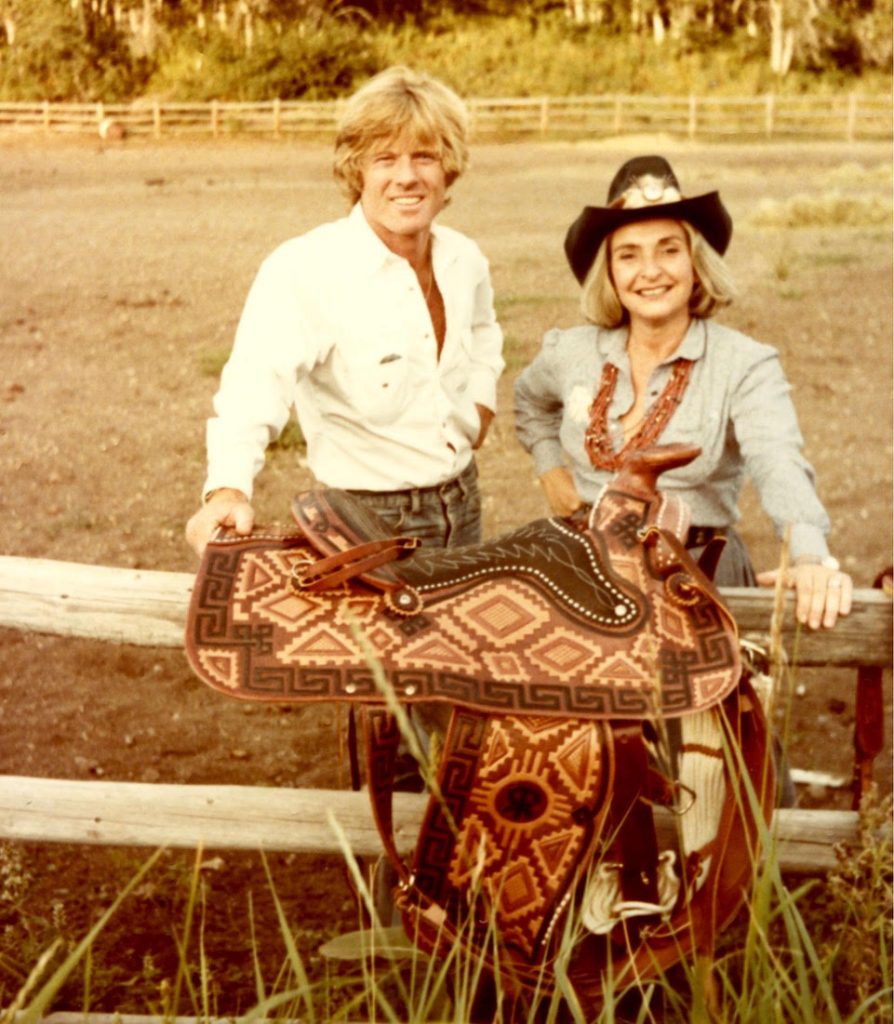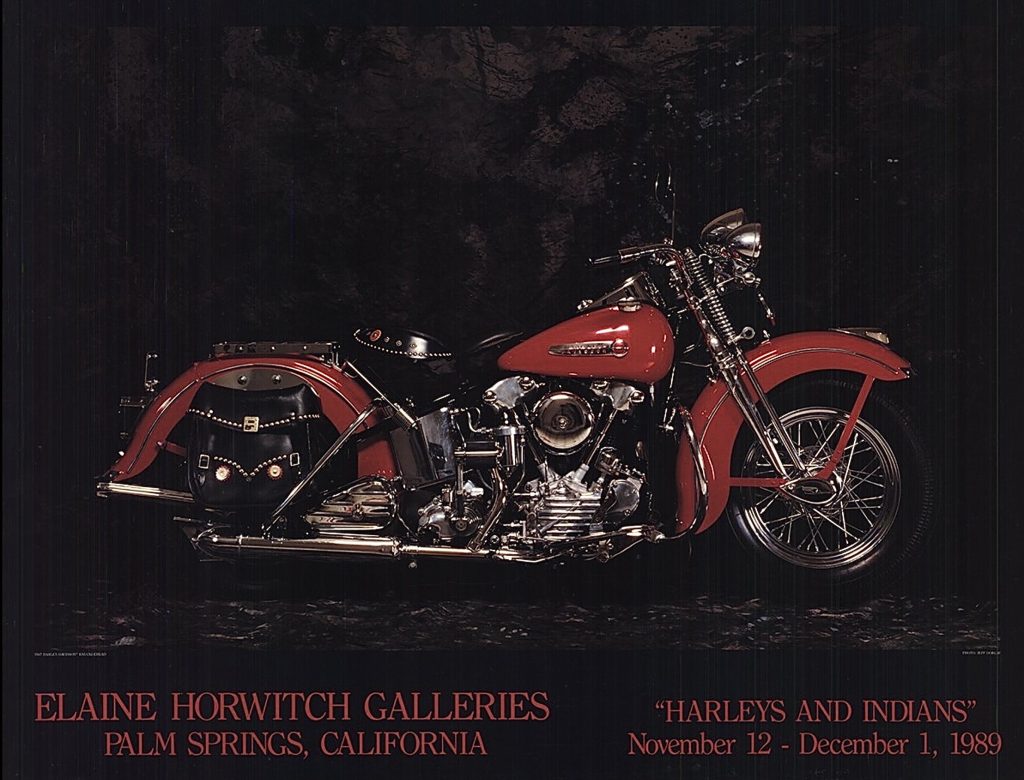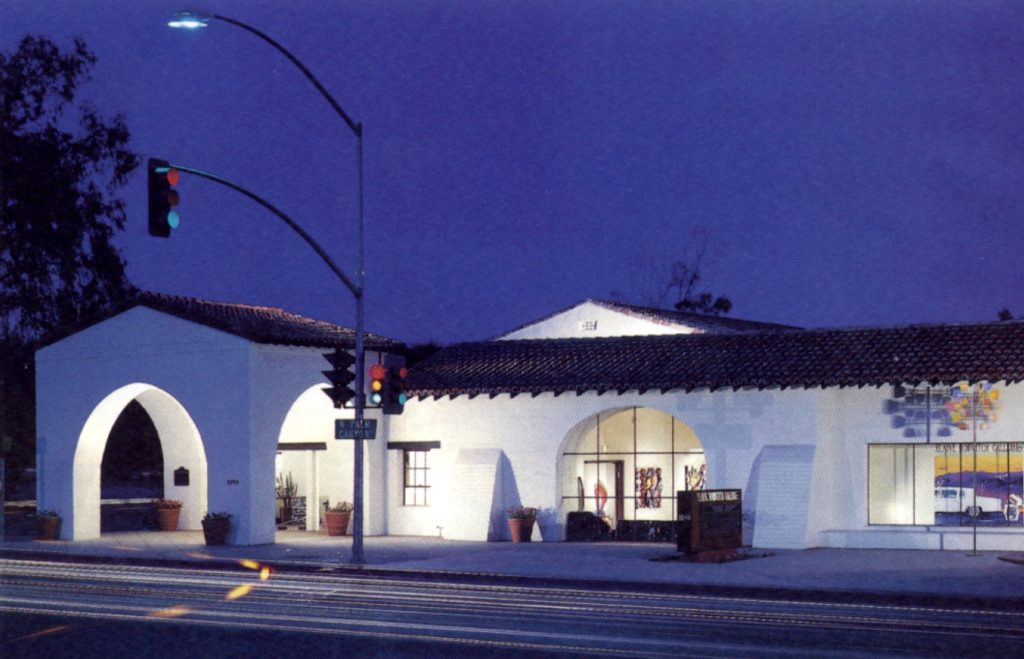Editor’s note: In the 1980s one of the most influential art dealers in the West decided that Palm Canyon Drive was destined to be an arts district and she was the person to make it happen. To that end, Elaine Horwitch purchased a 1929 building at 1090 North Palm Canyon—the former garage for the El Mirador Hotel and a staging area for the Desert Circus parade–and opened the Elaine Horwitch Gallery.
The little-remembered episode in desert art history forever links Palm Springs to the Santa Fe and Scottdale art scenes. It’s a chapter in a new book by Julie Sasse, chief curator for the Tucson Museum of Art. Sasse worked for Horwitch during the Palm Springs years and acts as an omniscient narrator, bestowing benevolence on even the most challenging characters.
Elaine Horwitch was a mother of five who got her start by selling paintings out of her station wagon (she called it The Art Wagon) in Scottsdale. It was her version of the Tupperware party. In the 1970s and 80s, she opened galleries in Santa Fe, Sedona, Scottsdale and Palm Springs, popularizing a contemporary approach to Western art that came to be known as Southwest Pop. “She was easily the most significant art dealer that ever lived outside of NY or LA,” said artist Billy Schenck.
The following excerpt from Southwest Rising: Contemporary Art and the Legacy of Elaine Horwitch shows Horwitch’s stylish bravado as she packs a pearl-handled pistol, rides horses at Smoke Tree and flies around in her private plane. The Palm Springs gallery closed in 1989. Horwitch died in 1991. The Palm Canyon art scene never quite materialized and the former gallery is now a physical therapist’s office.
Sasse’s book is an expansive history of Southwest art, encompassing stars such as Louise Nevelson, Robert Rauschenberg, Fritz Scholder and Georgia O’Keeffe. The book has inspired exhibitions at the Tucson Museum of Art, the Booth Museum and–currently through January 2nd, 2022–the New Mexico Museum of Art. If there is justice in the art world, Elaine Horwitch will one day return to Palm Springs in the form of an exhibition dedicated to her influence. Excerpt from Southwest Rising:

Robert Redford and Elaine Horwitch, Sundance, Utah, 1981. Courtesy of Nancy Silver. Redford was a frequent visitor to Horwitch’s Santa Fe gallery.
In 1986, upon the twenty-fourth anniversary of Elaine Horwitch Galleries in Scottsdale, the twelfth anniversary of the Santa Fe gallery, and the new Sedona gallery underway, Horwitch was getting restless and eager to find a new location for her many artists and collecting interests. Years earlier, she had started to think about opening a business in Palm Springs, but other projects got in the way. She had scouted for potential gallery sites in Aspen and Denver, but nothing panned out. Horwitch preferred locations that were tourist destinations, declaring that “people had more time to look at art and to be motivated to buy it when they were on vacation in an exotic location.” Finally, she and Arnold started to look for a new gallery in Palm Springs. They found the perfect location, a 15,000 square-foot building on 1090 North Palm Canyon Drive and made an offer.
Originally built in 1929, the building was once the area’s first gas station and the garage for the limousines of visitors at the famous El Mirador Hotel, frequented over the years by celebrities such as W. C. Fields, Clark Gable, Gary Cooper, Albert Einstein, and Marlene Dietrich. When the hotel closed in 1973, the garage was condemned by the City of Palm Springs and in danger of being demolished. The structure had 3,400 square feet of living quarters formerly used by limo drivers who once paid $2.50 a night to stay in little cubicles near their vehicles; it would make a perfect apartment above the spacious gallery. The Horwitches soon set to the task of having the building renovated.
Working with the Palm Springs Historic Site Preservation Board, the Horwitches hired well-known Rancho Mirage architect Michael Kiner to restore and remodel the building. Patrick Neary, a close friend and exhibit designer from the Heard Museum in Phoenix, oversaw the interior design and layout. Horwitch considered the building itself to be a work of art and believed that Palm Canyon Drive would become a new art hub. Spacious and airy with cement floors and wood trusses supporting an arched ceiling, the gallery could accommodate large-scale paintings and sculptures that were her trademark. Horwitch spared no expense for her living quarters on the second floor, designed by Carla Kalwaitis. Furnishing the apartment was an exciting project. According to Kalwaitis, “We had so much fun. One time, a guy came in to sell her furniture and had on a great pair of cowboy boots. Elaine asked, ‘How much for the boots?’ She bought them right off the man, who left in his socks, and we filled them with plaster and made them into lamps for the apartment.” They commissioned California ceramicist Marlo Bartels (b. 1956) to tile her kitchen with a large rattlesnake gracing the backsplash, and filled the black-and-white interior with works by David Gilhooly, Nevelson, and Fonseca; a Cadillac Couch; and assorted folk art. Calling her style “outrageously eclectic,” Horwitch was unabashed when explaining her aesthetic, declaring, “I can live with things that make me smile.”

David Bradley, The Elaine Horwitch Indian Market Party, 1984. Collection of Thomas Druyan and Alice Ladner. Courtesy of David Bradley.
Horwitch then hired Sidney Williams as her gallery director, the daughter-in-law of noted desert modern architect E. Stewart Williams, known for designing the Palm Springs Desert Museum and Frank Sinatra’s desert getaway. Williams was the first Chair of the Contemporary Art Council at the Palm Springs Desert Museum and taught at California State University, San Bernardino Palm Desert Campus, and the University of Redlands, so her art history background was as impressive as her social connections. Soon after, Horwitch hired Kalwaitis, Jacqueline Christian, Constance Walsh, and Carolyn Goodman to round out her California team. Staff from both Scottsdale and Santa Fe made regular trips to Palm Springs to deliver art, participate in openings, and assist in creating special exhibitions. Favored Santa Fe employee Nicholas Sealey moved from Santa Fe to Los Angeles, commuting to Palm Springs to join the crew.
When Horwitch’s gallery opened, locals came to see her as much as the artists and the gallery. Calling her an “expert on Southwestern art,” the press lauded her ability to promote under-recognized artists. As one reporter notes, “She helped sculpt the Southwest art tradition from the sands of Arizona and New Mexico, with several of her artists emerging from desert anonymity to the mecca of American art—New York City’s Metropolitan Museum.” Williams noticed that much of Horwitch’s appeal in Palm Springs was what Horwitch and Pfaelzer playfully called “Jewish geography.” According to Williams, “Everyone knew everyone, and if someone from Tamarisk Country Club bought something from Horwitch’s gallery, they would have a party to show it off, and soon their friends would come in to get something just like it.”

Elaine Horwitch staged a major show of motorcycles-as-art in Palm Springs. Photograph by Jeff Dorgay.
On November 22, 1986, more than thirty artists came from around the country to the grand opening, attended by more than 900 guests. Horwitch, dressed in a black sequined bomber jacket with racing patches marked “Jaguar” on the back, made her gallery debut with a large group exhibition and selections of her finest Indian jewelry. The gallery declared its focus on “emerging Southern California artists,” but works by her most popular artists from all over the country were on display, including Duecker from Oklahoma; Jenkins, Rivers, and Frankenthaler from New York; Fincher, Wade, White, Coffin, and Havard from New Mexico; established artists Guy Dill (b. 1946) and Roland Reiss (b. 1929) from California; and Baker, Kraisler, and Yasami from Arizona, among others. The eclectic mix of art did not deter collectors from coming from Los Angeles in great numbers—it was Elaine Horwitch Galleries after all.
Taking accolades for his impressive gallery design, Kiner was joined at the grand opening by his wife, Kathleen Sullivan, the co-anchor of ABC’s “World News This Morning.” Live models from Bullock’s Wilshire, wearing some of Horwitch’s best Indian jewelry, mingled among the guests who sipped on margaritas while a mariachi band played—one turquoise and silver concho belt sported a price tag of $75,000.00. A local social columnist declared, “The gallery opening attracted what has to be the most eclectic and dazzling group of people ever seen in this oasis.” The locals were happy to have Horwitch’s expansive gallery in their city. Longtime Palm Springs residents who joined Mayor Frank Bogert in the festivities included Walter and Doris Marks, major donors to the Palm Springs Desert Museum; Alice Tipton, interior designer and Historic Site Preservation board member; and city councilwoman Sharon Apfelbaum. Horwitch had triumphed again; her gallery was the talk of the town.
Creating a buzz in Palm Springs like Scottsdale and Santa Fe, Horwitch aimed to go big with her exhibitions and openings. In November of 1987, her Palm Springs gallery presented Artists of the Western States Exhibitions, which featured gallery artists who had been part of the Western States Arts Foundation’s exhibition series: Baker, Dillingham, Fincher, Hall, Jiménez, Kraisler, Mahaffey, Scholder, Swartz, Wade, and White. To emphasize the importance of her artists and make another splash in Palm Springs, Horwitch hired David Wynne from Santa Fe to serve Cajun food, and secured Queen Ida and the Bon Temps Zydeco Band to perform their unique brand of Southern Louisiana Creole music. Queen Ida was a strategic choice for the opening; she had been selected to be a part of the 1988–1989 Western States for Performing Arts Tour. Hundreds of people attended the opening reception, and artists and collectors flew in from Santa Fe and Scottsdale for the big event.
Horwitch was determined to make her Palm Springs gallery as important as her Santa Fe and Scottsdale galleries, and she often adjusted her exhibitions to accommodate the different aesthetics in the area. In 1988, showing some of her longtime artists Klotz, Kraisler, and Tobias, she also presented works by Beatrice Wood, noted Chicago fiber artist Claire Zeisler (1893–1998), and Los Angeles artist Joe Fay (b. 1950). Knowing the sophistication of her Palm Springs clientele, she also presented Master Graphics, which included nationally recognized artists Arnoldi, Botero, Christo, Jim Dine (b. 1935), Frankenthaler, Grooms, Haring, Nevelson, Rauschenberg, and Rivers. Her formula of mixing established with emerging artists worked. For each sale of a major artist, she enticed collectors to take a chance on a Southwest newcomer.

The author of Southwest Rising, Julie Sasse, at right, with Carla Kalwaitis at the Harleys and Indians exhibition in Palm Springs, 1989. Courtesy Elaine Horwitch Galleries.
In the fall of 1988, Horwitch presented Textures, a group exhibition of works by John Babcock (b. 1941), Patrick Crabb (b. 1948), Jacqueline Draeger (b. 1944), Trude Parkinson (b. 1940), and Karyl Sisson (b. 1948), lesser-known artists than her Scottsdale and Santa Fe mainstays and more poetic in their approach. Casting a wide net, Horwitch also presented Cowboys and Indians, an exhibition featuring Coe, Bradley, Brubaker, Fonseca, Hertel, Judson, Prescott, Schenck, Tobias, Wade, and Thom Wheeler (b. 1946). She was confident that Palm Springs collectors would embrace contemporary artists from Arizona and New Mexico and that Southwestern themes would become popular in the southern California resort town. Even Palmore became curious. One day, he stopped by to check out Horwitch’s gallery, finding her there. Calling out to her to say hello, she came over to him and soon they were talking like old times. Upon leaving the gallery, Palmore recalls, “I turned to her and said, ‘I know why you are being so nice to me.’ And she said, ‘Oh, why is that?’ And I said, ‘Because you screwed me last.’ But then I said, ‘But guess what? It’s not over yet.’ And we both laughed.”
Horwitch was all business, but she could also be spontaneous and playful, even in Palm Springs. Employee Kalwaitis, who also lived in the apartment above the gallery in Palm Springs, became close friends with her. They went riding near Smoketree Stables, where Horwitch kept her Peruvian Paso horse, dining at Sherman’s Deli and the Swiss Donut shop, and shopping for salt and pepper shakers at the Yucca Valley swap meet, among other excursions. Kalwaitis recalls Horwitch’s reaction when she ordered a sandwich with mayonnaise on it at Sherman’s. Appalled, Horwitch declared, “Don’t ever do that again!” and they both had a big laugh. At Horwitch’s inspiration, they would jump in her plane and fly to Phoenix, and once, they flew to New York City to attend a Christie’s auction and pay a visit to Larry Rivers in his studio. Kalwaitis was one of the few employees from Palm Springs who was invited to work in Santa Fe during the summer, a coveted opportunity to have fun and meet important collectors.

Horwitch’s Angels: After Elaine Horwitch died in 1991, this Mike Ritter drawing appeared in the Scottsdale Progress. Courtesy Mike Ritter and Scottsdale Progress.
One day in the 1980s, Horwitch approached artist Jeff Low to go on an adventure with her to Palm Springs. Frank Sinatra was giving a benefit concert for the Palm Springs Desert Museum and she wanted to go. Throwing a pile of clothes and shoes in the back seat of her Rolls-Royce, she scooped up Low and drove at top speed from Scottsdale to Palm Springs, a four-hour drive on Horwitch time. When Low asked who would be at the event, she replied, “Just a couple of ex-presidents and other dignitaries.” Remembering she usually kept a loaded gun hidden in her clothes, Low begged her to leave it at home so the security detail would not stop them. Once in Palm Springs, Horwitch transformed from a cowgirl to a celebrity in her own right. As Low recalls:
We walked through the door, and the lights started flashing, and suddenly she wasn’t my Elaine; she was a big deal—the person that everyone else knew. Dinah Shore was there, and President and Mrs. Ford, and Nancy Sinatra—we were placed next to Sinatra’s table. I asked Elaine to introduce me to Betty Ford and she said, ‘Just go over and introduce yourself,’ so I worked up the courage to speak to her. Afterward, Elaine said teasingly, ‘Look who’s talking to Betty Ford!’
Order Southwest Rising: Contemporary Art and the Legacy of Elaine Horwitch: https://www.tucsonmuseumofart.org/product/southwest-rising-contemporary-art-and-the-legacy-of-elaine-horwitch/
See the Southwest Rising exhibition at the New Mexico Museum of Art through January 2, 2022. https://nmartmuseum.org/art/exhibition-details/2021/4469/southwest-rising-contemporary-art-and-the-legacy-of-elaine-horwitch





Purdy Dang Cool and Fabulous!
I have long admired that building as I sat inside the coffee shop across the street without knowing anything of its history. I knew there was something special about it though. Thanks for this fascinating bit of history of the structure and Ms. Horwitch’s gallery there.